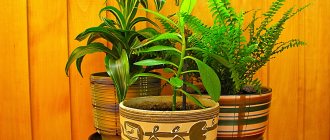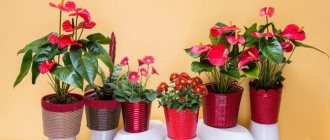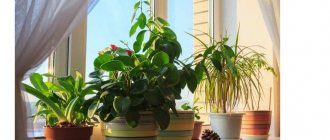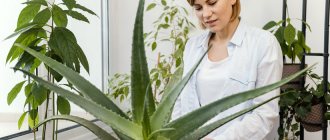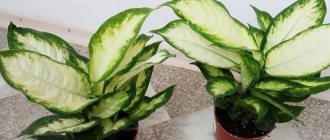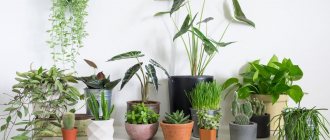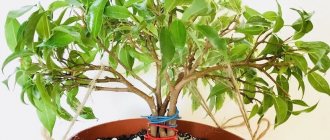The 15 best indoor flowers you should have in your apartment. Read the article about why and how they affect a person.
Indoor flowers bring beauty and comfort to your home. It’s hard to argue with this, but in order for plants to feel good, they need to find optimal conditions for existence. Choosing a location is one of these conditions.
Read an article on our website about how to properly replant an indoor flower in a pot . You will find out what reasons there are for this and what is necessary.
What indoor flowers should be in the house, and which ones are not advisable to have? Where should they be? Find answers to these and other questions in this article. Read on.
Where and how should indoor flowers be placed: according to Feng Shui, in the children's room, kitchen, bedroom
Indoor flower
It is clear that when a new flower appears in the house, the housewife tries to find the best place for it, i.e. so that it does not interfere with the inhabitants of the apartment or house, and, at the same time, it can be constantly admired. But the location of the flower can also enhance or, conversely, reduce the influence of certain aspects of life and the energy that is present in the home. Where and how should indoor flowers be placed?
To create positive energy, you need to follow several not very complicated rules according to Feng Shui:
- There should be no artificial flowers in the house - they have very bad, one might even say dead, energy.
- The same can be said about flowers that show signs of wilting - their influence will negatively affect the inhabitants of the house, they are immediately removed.
- Indoor plants in the bedroom can negatively affect marital relationships because they enhance the yang energy in the room.
- It is forbidden to place flower pots in open spaces ; their place is on special shelves or niches, where energy is retained and distributed throughout the space.
- Relaxation areas seem to be specially designed for admiring flowers , but they do not need to be placed directly next to the sofa or lounge chairs. It is better to place them so that they are clearly visible, but at a slight distance.
in a children's room because there is a high risk of injury to the child if the pot turns over. In addition, some flowers may contain toxic substances in their leaves or stems, and children, out of curiosity, may chew a leaf and become poisoned.
The kitchen is a good place for flowers, but only if it is large enough. Otherwise, the hot air from the stove may damage the plants and they may die. On a kitchen window sill, large plants will shade the room, but small pots of violets or cyclamen are quite suitable for decorating window sills in this room.
Planting tools.
Once you have decided on a pot, you will need tools for planting and caring for flowers. Many people don't use tools. However, almost every gardener should have a set of tools for working with plants:
- - spray bottle - needed for spraying plants. A volume of 1 or 2 liters is suitable. If you have more than ten plants, it is better to purchase 5 liters.
- - scissors - choose them for trimming plants. The ends of the scissors must be strong. Stationery ones are not suitable, so pay attention to the garden model.
- - transplanting spatula - you will use it to pour soil into a pot, or remove plants from a multiple composition.
- - paw - it is used to break the soil crust that forms on the surface. You can use a regular fork instead.
- - material for garter - to garter plants, use natural materials, wire, rings. The supports are either plastic or bamboo. They will be needed for garter and support. The choice of supports and special means for tying are determined by the types of indoor plants. Tying and supporting do not complicate the care of indoor plants.
- rakes - they are convenient for loosening and leveling the soil. Very convenient for large flower pots and tubs.
All instruments must be thoroughly washed and cleaned after each use. Wipe them dry and put them away.
Indoor flowers that must be in the house: 15 best flowers for home and apartment
Experienced flower growers know that some flowers have a good effect on the energy and atmosphere of a home and a person, while others are best avoided and not planted in a living room. This is due to various factors, including the fact that plants can be simply poisonous and emit substances harmful to humans or domestic animals. Below you will find a list of indoor flowers that must be in the house. These are the 15 best colors for home and apartment:
Aloe is an indoor flower that must be in the house
- ALOE
This green plant is not very impressive in appearance, but its benefits significantly outweigh this drawback. This is a medicine flower. With its help you can cure colds and inflammations, heal wounds, and stop bleeding. It has a very good effect on the skin. Therefore, it is often used in cosmetology; it is part of cosmetic masks for aging skin.
Violet is an indoor flower that must be in the house
- VIOLET
A little was said about this plant above, but it is used not only for beauty. It can quite effectively clean the kitchen of carbon monoxide, and slightly humidify the dry air. The wide palette of colors of modern varieties of violets even relieves depression.
Geranium is an indoor flower that must be in the house
- GERANIUM
The lush greenery of this plant and highly decorative flowers have made it popular among gardeners. Geranium can also rid your home of moths and pathogens. Fragrant inflorescences will help with headaches and relieve nervous tension, helping you to sleep peacefully.
Crassula is an indoor flower that must be in the house
- PASSIONATE
Or money tree - this plant is more familiar under this name. It is called so because of the similarity of the small round leaves with coins. The stems of the crassula are densely hung with these “coins”. Because of this, it is believed that the plant can attract banknotes.
Citrus fruits are indoor flowers that must be in the house
- CITRUS
A blooming lemon or orange is simply a fantastic sight, not to mention the amazing aroma of the flowers. True, only owners of fairly large kitchens can afford such a luxury - citrus fruits in adulthood are quite large plants. The fruits and leaves release essential compounds that can relieve stress and soothe irritation.
Anthurium is an indoor flower that must be in the house
- ANTHURIUM
When people see this flower for the first time, they confidently say that it is artificial. The spectacular red inflorescence seems to be made of plastic. Beautiful dense leaves, if they are healthy, also look like artificial ones. But these leaves can absorb harmful impurities released by modern finishing materials.
Calla is an indoor flower that must be in the house
- CALLA
A bouquet of these graceful flowers is often held in the hands of the bride at a wedding ceremony. Now varieties not only of white, but also of other colors have been bred. But only the white calla is a royal flower. It can be grown at home on a windowsill, although only experienced gardeners can do this.
Camellia is an indoor flower that must be in the house
- CAMELLIA
An elegant, but rather capricious flower that requires special attention. The inflorescences of this plant resemble miniature peonies. Shiny leathery leaves add decorativeness to the entire flower. This is an infrequent guest in apartments, due to its demands on environmental conditions.
Kalanchoe is an indoor flower that must be in the house
- KALANCHOE
Another “family doctor” who helps to cope with certain diseases. Only, unlike aloe, it belongs to a different family - Crassulaceae. Some species are so decorative that they began to be sold in bloom, along with miniature roses, orchids, and azaleas, at New Year's flower shows.
Cyclamen is an indoor flower that must be in the house
- CYCLAMEN
Another frequent guest at New Year and Christmas flower sales. It blooms mainly in winter with beautiful, butterfly-like flowers in delicate shades of pink. The difficulty in keeping this flower lies in preserving it during the dormant period, which occurs in the summer, when the flower must be stored at low temperatures.
Orchid is an indoor flower that must be in the house
- ORCHID
For some flower growers, this is a real antidepressant, capable of distracting a person from negative thoughts and giving joy simply by its presence. One of the best indoor flowers with very high decorative flowers and leaves.
Dracaena is an indoor flower that must be in the house
- DRACAENA
Feng Shui experts often recommend having this flower at home. He is able to accumulate positive energy and give it to his owner. Quite unpretentious in maintenance, but rarely blooms, but has decorative leaves.
Monstera is an indoor flower that must be in the house
- MONSTER
Large flower for large rooms. The leaves require constant attention - they need to be frequently wiped with a damp sponge, sprayed, and watered. But the plant is majestic, it gives a feeling of being in the jungle, where, in fact, it came to us.
Azalea is an indoor flower that must be in the house
- AZALEA
A flower that loves cold and shade. Having created such conditions, you can admire its spectacular flowering for a long time. But this is difficult to achieve in summer. Therefore, the plant is not very popular and you rarely see it on windowsills or shelves. Although experienced gardeners grow azaleas and are not going to give them up.
Fern is an indoor flower that must be in the house
- FERN
It has decorative foliage, never blooms, and reproduces only vegetatively. Several types of fern are grown at home. This plant does not like heat or direct sunlight; it needs to be sprayed frequently to increase the humidity of the surrounding air. Such conditions are comfortable for him, and he can live in the apartment for decades.
What flowers should not be kept at home: prohibited list, reasons
Now you know which flowers to give preference to when growing them in the house. But you should also know about plants that are best not kept at home. There can be many reasons for this, ranging from the negative energy that affects people to the harmful substances released. What flowers should not be kept at home? The reasons are described below. Here is the prohibited list:
Oleander - should not be kept at home
- OLEANDER
All parts of the plant are poisonous - leaves, roots, and flowers. Although the plant during the flowering period is very decorative and emits a strong aroma. It also does nothing good for human health. On the contrary, inhaling the smell of oleander, you can feel dizzy and decrease in overall well-being. And if the juice of this plant accidentally enters the human body, it can cause visual impairment.
Alocasia - should not be kept at home
- ALOCASIA
In alocasia, just like in oleander, all parts are poisonous. But thanks to its large arrow-shaped leaves with pronounced, light veins, it is quite well known to flower growers. It is grown mainly in offices, but is usually placed in inaccessible places so as not to cause accidental poisoning.
Dieffenbachia - should not be kept at home
- DIEFENBACHIA
A fast growing plant with large beautiful leaves. It looks like a small tree. The leaves are poisonous. If the juice gets into the oral cavity, life-threatening tissue swelling may develop. Therefore, it is forbidden to keep it in an apartment where there are small children and animals.
Ficus - should not be kept at home
- FICUS
This plant should not be kept in an apartment due to the fact that it actively absorbs oxygen from the surrounding air. There’s not much of it in houses anyway, so there’s no need for a competitor in this matter. In addition, this is a fairly large plant, it needs to be looked after to ensure that the leaves always look healthy and shiny.
Gloriosa - should not be kept at home
- GLORIOSA
A plant with unusually beautiful exotic flowers. But it is forbidden to keep it at home because of its poisonous juice, which can even be fatal. The seeds and roots of the plant are also dangerous. Gloriosa toxins cause severe vomiting and can lead to kidney failure. Therefore, it is better to abandon such a plant.
Transfer
The main and important condition for growing a crop is replanting. This process can improve and normalize flowering.
Reasons why you should replant a plant:
- The rhizome grows and the pot becomes too small (this usually happens after purchasing a ready-made flower in a store);
- Root disease or rot.
Adult individuals that do not exhibit deviations in growth and development, diseases and other external defects are transplanted using the transshipment method twice a year.
The flower itself will tell you that it needs replanting: the root system will begin to peek out from the drainage holes of the pot. Thus, the rhizome will produce additional moisture and nutrients.
How to transplant an anthurium? To prevent the rhizome from being damaged, the soil is first moistened. When removing the plant from the pot, you should check the roots for rot or disease. If everything is fine with the crop, then you can transplant it into another pot with a drainage layer at the bottom.
In another article we described: How to care for Adromiscus at home
In order for the crop to bloom faster after transplantation, the new container should be slightly larger than the previous one. Flower growers advise choosing containers based on the following criteria: height is equal to diameter.
A lump of earth with roots is placed in the center, and the space on the sides is filled with soil. It needs to be compacted and watered if necessary.
If the rhizome appears painful or rotten in appearance, then the transplantation process will have a slightly different algorithm.
The florist must pay attention to:
- The appearance of spots on leaves or stems;
- For loss of tone;
- For slow growth and development;
- To stop the appearance of inflorescences.
Those areas that are rotten or damaged must be removed. Those places that have been cut are treated with charcoal in powder form.
Leaves, buds and peduncles that have already dried are also removed. The crop will tolerate transplantation more easily because it will not waste its energy on unnecessary dried elements.
If the flower has suffered late blight disease, then after transplantation it is necessary to monitor it. If symptoms recur, the crown is treated together with the rhizome and soil.
After the culture is transplanted, additional care is necessary. Watering is not recommended until the top layer of soil is completely dry. Drafts and rays of the sun during this period can negatively affect the condition of the flower.
There is no need to fertilize the soil for about two months. At this time, the rhizome will undergo adaptation to the new substrate. Fertilizing will only burn the roots of the anthurium.
How long should a phytolamp for indoor flowers work?
Phytolamp for indoor flowers
One of the main characteristics of indoor plants is their attitude to light. On this basis they are divided into 4 groups:
- Sun-loving plants - aloe, ficus benjamina, cyperus, coleus and others.
- Light-loving plants - dracaena, Kalanchoe, cyclamen, citrus fruits, geranium.
- Shade-tolerant - anthuriums, ferns, some orchids, etc.
- Shade-loving plants - monstera, oxalis, indoor grapes, etc.
Based on this, you can determine how many hours a day certain indoor plants should be illuminated. How long should a phytolamp for indoor flowers work?
- One important point should be noted right away - even sun-loving plants should not be provided with round-the-clock illumination.
- At night, all flowers undergo important processes that cannot take place in the light.
More details:
- Sun-loving plants should be illuminated at least 4-5 hours a day in winter.
- One hour in the morning and the rest in the evening, i.e. They turn on the lights at 7 a.m. and turn them off at full sunrise.
- In the evening they turn on at dusk and turn off at 21:00 . It is clear that the flowers should be on the windowsill or in close proximity to the window.
Worth knowing:
- For those who love light , this time can be reduced by an hour or an hour and a half, while their location can be determined at a distance of no more than 1 m from the window.
- For shade-tolerant and shade-loving flowers, turn it on in winter, for example, in December - for no more than half an hour. Shade-loving flowers are placed at a distance of 3-4 m from the window, and shade-tolerant ones can be placed in the darkest corners of the room.
Now you know which flowers you can plant and which you shouldn’t. Don’t forget to turn on the phytolamp, especially for light-loving plants that lack warmth and light in winter. Good luck!
Plant propagation
To propagate a flower, you can use several methods. Usually, when choosing, the capabilities and skills of the grower and the health status of the crop are taken into account.
Reproduction by division
Division. This method is only suitable for crops that are more than three years old. Care does not include any unusual actions. The process only rejuvenates the flower and allows you to get new plants. It is recommended to carry out such propagation in the spring.
Algorithm of actions:
- The soil is wetted;
- Remove the earthen ball with the root system from the container;
- Carefully clean it of excess soil;
- The roots are unraveling;
- They are processed and disinfected;
- Divide them into several parts;
- Plant in new pots.

